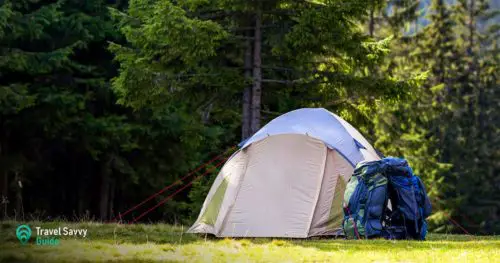Camping can be a budget-friendly activity, and in our guide to the Best Tents Under $200, we’ll be looking at some of the best models out there for a low price.
If you want to get into camping but you don’t have a lot of spare cash, you may feel it is out of your reach. It doesn’t have to be that way. The most expensive items tend to be the actual tent, and the sleeping pads – and even they can be budget-friendly. Plus, having a tent will save you money in the long run, as camping tends to be much cheaper than staying in hotels or RVs.
At A Glance: Our Top 3 Picks for Best Tents Under $200
- Coleman Instant 8-Person Tent – Best for Families
- Kelty Late Start – Great for Solo Travellers
- Mountainsmith Morrison 2-Person 3-Season Tent – Most Versatile
This guide may interest you if you’re a backpacker, too – we will be looking at some cheap and lightweight models that fold down small, so they’ll be perfect to carry on long hikes.
In this guide, we’ll be looking at:
- Things to look for when choosing a new tent
- 5 of the best budget-friendly tents under $200, including their specifications, features, and pros and cons
- Some of the most frequently asked questions about tents
- Our conclusion – which tents we think are best and why
Best Tents Under $200 – an Overview










What to Look at When Choosing a Tent on a Budget
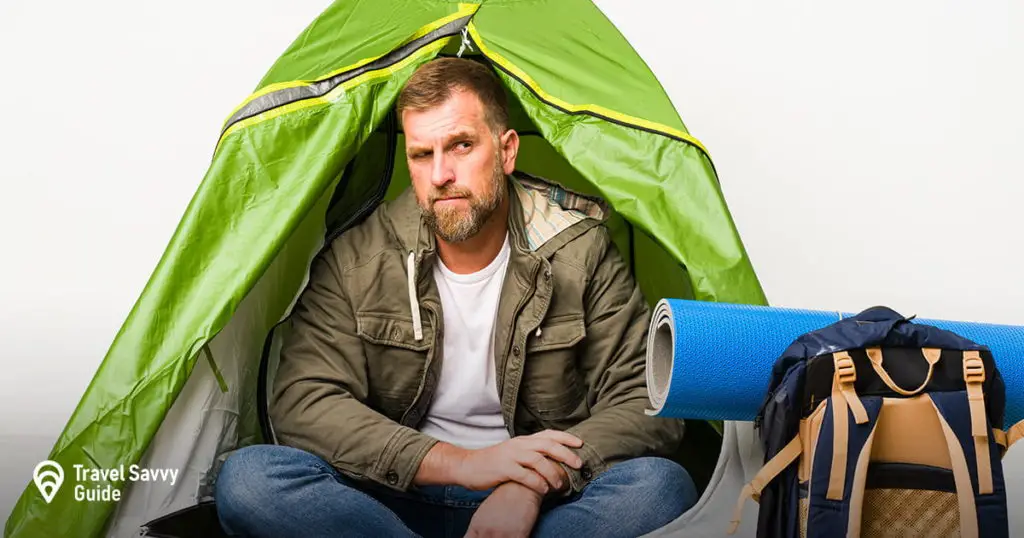
Price
This is the first and most obvious point if you’re on a tight budget. You can get some excellent tents for under $200. Checking out reviews is always a good idea if you are not sure of the quality.
You can buy tents second hand. We would always recommend having a thorough look at a used tent before buying, to check for holes, damaged or rusted poles, and general wear-and-tear.
Size and Layout
How many people will you be camping with, and how much space do you want? Bear in mind you may want space to store your gear too.
An 8-person tent will technically fit 8 people, but it might be a bit cramped. They are usually big enough to sleep 4-6 people with space for their gear. Along similar lines, a 2-person tent is usually only comfortably big enough for one person with all their gear too. For longer trips, you may want to spread out a little more, with more room per person.
Some tents offer overhead storage for gear. This is good if you do not want to store your gear in a vehicle but would like to keep it out of the way.
There is also the layout to think about. If you are a family or large group camping together, you may want to have a separate bedroom for your kids, or a living area that is separated from the bedrooms. These types of tents are great for families but may require a little extra time to put together. You may struggle to find one for under $200 if you have 6-8 people or more travelling together.
If you’re travelling, you may want to forgo separate bedrooms for a lighter tent to save space and weight. Some tents are designed for backpackers, with a focus on lightweight materials and a simple-to-assemble frame.
Tent Style
Tents come in different styles. Dome-style tents have a rounded top, whereas cabin style tents have straight walls.
Dome tents use a crossed-pole shape – this means they have extra poles to support the fabric. This provides some strength and stability in windy conditions. They also tend to be free-standing, which means you can camp on different surfaces without having to worry about attaching it to the ground using stakes and guy lines (a cord or string). You can also get half-dome tents – these are great for travellers as they’re designed to be lightweight. The downside to dome tents is the lack of space – they don’t have as much headroom as cabin tents.
Cabin tents have almost vertical walls, with plenty of headroom and floor space – great for multiple airbeds and gear storage. They usually have a lot of windows and multiple doors, which is good for ventilation. You will have to use guy lines, attaching one end to the tent and the other to a stake, which you will then drive into the ground. This means cabin tents are not suitable for rocky surfaces, but it does give them a lot of stability and strength in stormy conditions. The downsides to cabin tents are the weight and size – they’re heavy, and they don’t fold up as small as dome tents, making them less suitable for travelling.
Seasons
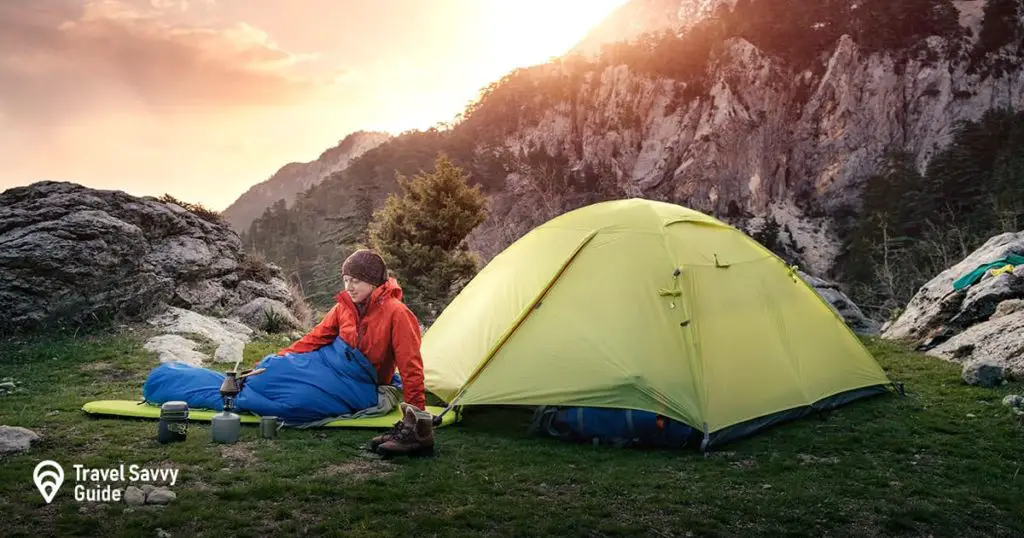
Tents will be marked with the seasons they are suitable for.
1 season tents
1 season tents are basic, intended only for use in the summer. They are very lightweight and won’t withstand much more than a shower in terms of bad weather conditions. They lack the weatherproofing that other tents have.
2 season tents
2 season tents are a little more robust than 1 season tents. Suitable for the spring and summer, they can withstand the odd downpour, but they won’t be any good for extreme thunderstorms or very cold weather.
3 season tents
3 season tents are good for spring, summer, and autumn. That covers a wide range of weather conditions, so they’re versatile. They are designed to withstand heavy rain and wind (this is down to a number of things, including the strength of the materials used, waterproofing, and sealed seams – we’ll talk more about weatherproofing shortly). They’re also well-ventilated with multiple doors and windows, making them suitable for hot weather.
4 season tents
4 season tents have a slightly misleading name, as they’re not actually designed for 4 seasons, but rather designed purely for cold weather. They lack the ventilation and breathability that you might need in hot weather, making them unsuitable for the summer. For cold weather, they are perfect. The fabric is usually double layered, keeping in warmth and keeping rain or snow out, and they’re usually waterproofed and sturdy to keep you dry in stormy conditions. This makes them very heavy to carry, but ideal if you want to camp in the winter.
5 Season tents
5 season tents are not for regular use. They’re designed for expeditions in the coldest and harshest weather – costing $1,000 or more, they are made to protect campers from snow dumps and to stay up in a blizzard. These are aimed at professional campers only.
You could get away with using a 2-season tent in the autumn if you have no other option. However, you could potentially run into some problems if it rains heavily or if the wind picks up. If you want a versatile tent that you can rely on, we’d recommend going for a 3-season tent, but if you’re only planning on camping in reliably sunny and hot conditions, a 2-season tent will suffice.
Weatherproofing
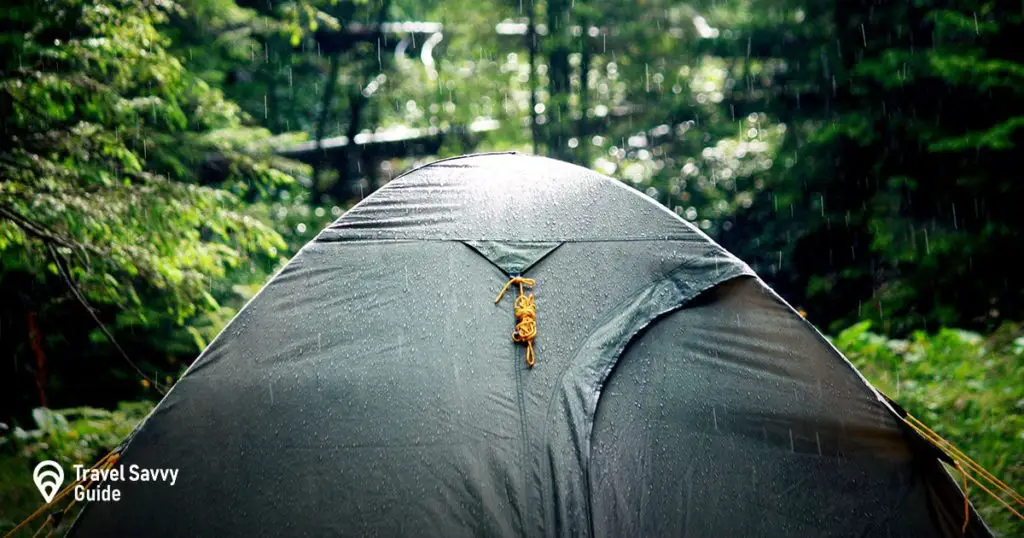
There are a few ways to weatherproof a tent.
The materials used are a big factor in weatherproofing.
- Cotton tents are rare to find. They are very lightweight. They’re brilliant for staying cool on hot days whilst providing warmth during the night. They have to go through a natural ‘weathering’ process before they can keep out rain, meaning you may experience a few leaks. When cotton tents get wet, the fibres in the weave swell and draw closer together, preventing the rain from soaking through. It usually takes a few weathering sessions to work.
- PVC (Poly Vinyl Chloride) coated tents are usually made from cotton, and then coated with PVC on the roof. Condensation can be a problem, but PVC is good at keeping rain out.
- Polycotton canvas tents are a mixture of cotton and polyester. These tents are usually coated to give extra waterproofing.
- Nylon tents are lightweight and tend to be cheap. They can be coated in a variety of things – acrylic, PU (polyurethane) or silicone. Acrylic is cheaper but wears out quickly, whereas silicone is the most expensive but lasts longer. PU coatings are somewhere in the middle of those. A nylon tent with silicone coating can keep rain out for a long time, but nylon is damaged by UV rays, so may not be so great for hot weather conditions.
- Polyester tents are usually coated in the same way as nylon tents, using the same materials (acrylic, PU, or silicone). But the polyester itself is more durable than nylon, meaning it should last longer – and it won’t get damaged by UV rays.
Materials Used for Weatherproofing
Most tents come with a rain fly – this is an outer layer that provides protection against the element whilst allowing the inner layer (known as the ‘tent body’) to breathe using mesh panels. A rain fly can fully or partially cover the tent depending on the design of the tent itself.
You can also buy a tent footprint – this is a piece of heavy-duty material that goes under the tent, providing a waterproof barrier. Some tents provide these as part of the design, and others do not, so it’s worth checking before you buy.
Tent poles (also known as rods) provide the structure of the tent, and the materials used for them can vary. You will most commonly find tent poles made from aluminum or fiberglass. Aluminum poles are lightweight and strong but can be prone to rust. They also pose a risk in thunderstorms as they conduct electricity. Fiberglass poles do not conduct electricity and are pretty cheap to buy. However, they are heavy to carry and can break more easily than aluminum.
Thermostatic head measurement
As well as the materials used, you can consider the thermostatic head measurement. This measures how water resistant your tent is, by measuring the height of the amount of water that pools on top of a tent during a rainstorm. This is measured in millimetres. A tent with a measurement of 157in/ 4000mm can hold a pool of water up to 157.4in/ 4000mm before it starts to leak through. A good measurement to aim for is around 75-120in/ 2000-3000mm. Not all tents advertise this measurement, however, so you may have to look at materials used instead to get an idea of how waterproof it is.
Finally, you can check if the tent has heat-sealed seams (this helps to prevent rain from entering the tent at the seams).
Extra Features
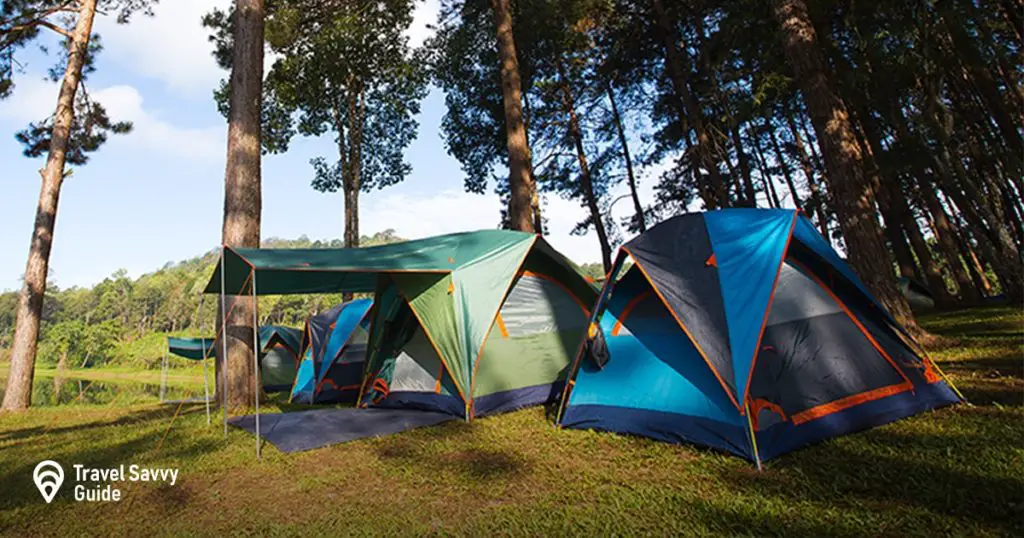
Tents come with a variety of features – from the small details (such as hooks to hang torches or lights on), to larger structural features (like a vestibule or porch area). They vary in design, for example, some have both front and back doors, and others have large windows to let in a good amount of daylight and provide ventilation.
Now let’s check out some of the best tents under $200.
Kelty Salida 2 Tent – Best Lightweight Tent
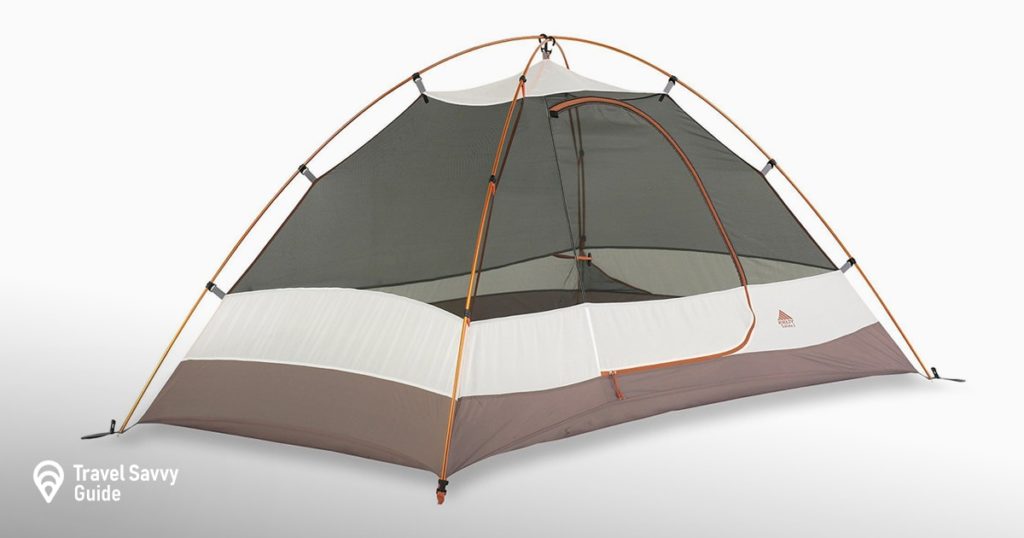
Key Features
- Sleeps: 4
- Size: 99 x 80 x 56 (in)/251 x 203 x 142 (cm)
- Size packed: 13 x 17 (in)/33 x 43 (cm)
- Weight: 6lb 10oz/2.7kg
- Materials
– Walls: Polyester
– Floor: Nylon - Seasons: 3
- Backpack-friendly compact folding poles, Gearloft loops, Color coded clip and fly attachment.Wall material: 68D Polyester, 40D No-See-Um Mesh,Floor material: 68D Nylon, 1800 mm
- Roll top cube carry bag, Easy set up, Free standing, Fabric/mesh tent walls
- Kelty hug clip, Easy entry D door, Internal storage pockets, Fully seam taped construction
- Seasons: 3, Number of doors: 1, Number of vestibules: 1, Number of poles: 2, Capacity: 4
- Floor area: 55 ft² / 5.11 m², Vestibule area: 11 ft² / 1.02 m². Wall material: 68D Polyester, 40D No-See-Um Mesh,Floor material: 68D Nylon, 1800 mm
The Kelty Salida 2 is a free-standing dome tent in an attractive white and green design. It is spacious with plenty of floor space, with an oversized door and plenty of ventilation throughout. It has internal storage pockets for storing gear.
In terms of weatherproofing, the seams are coated to prevent leaks, and the nylon is great for keeping out rain (but may wear out over time in sunny weather, which is something to consider). One downside is that it doesn’t come with a decent waterproof flooring, which means you’ll have to buy a heavy-duty tarp to lay under the tent before you assemble it.
It’s perfect for travellers as it folds into a very small and lightweight cube, making it easy to carry. It is simple to put together, too, with just two folding tent poles. Some experienced users can set up this tent in under 5 minutes, but it’s simple enough for beginners too. You can check the latest price for the Kelty Salida 2 here.
Pros
- Good waterproofing on the top and sides
- Easy to put together
- Lots of floor space
Cons
- Water can seep in through the bottom of the tent
- Nylon can wear out when exposed to UV rays over time
Mountainsmith Morrison 2-Person 3-Season Tent – Most Versatile
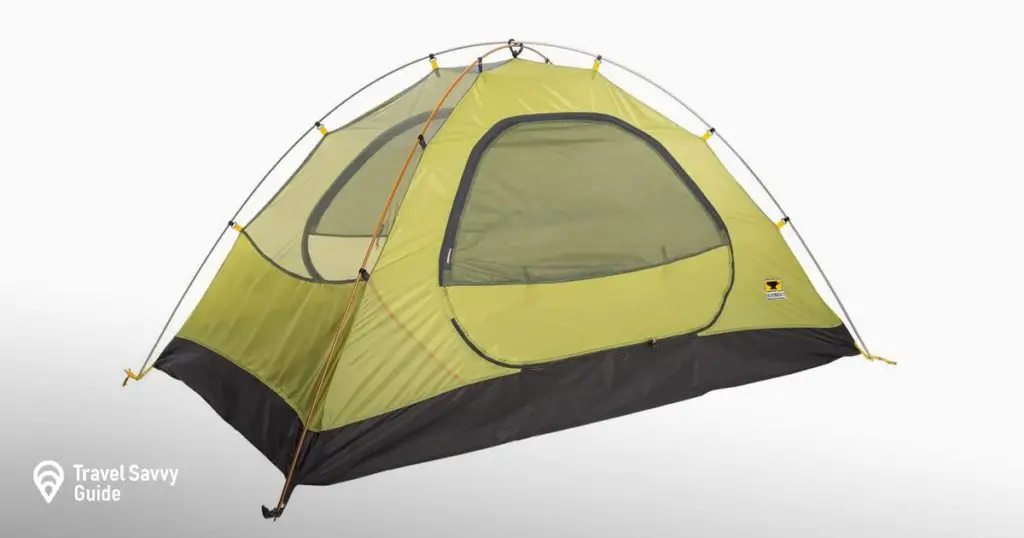
Key Features
- Sleeps: 2
- Size: 92 x 56 x 43 (in)/233 x 142 x 109 (cm)
- Size packed: 7.5 x 18 (in)/20 x 46 (cm)
- Weight: 4lb 11oz/2.2kg
- Materials
– Rainfly: 2000mm PU-coated polyester
– Floor: 5,000mm PU-coated polyester
– Tent Body: Polyester
– Tent Storage Sack: 30-denier nylon - Seasons: 3
- Two door / Two vestibule layout
- Two person layout
- Three season, free standing tent
- Tent fly ventilation windows
- Bathtub floor construction
The Mountainsmith Morrison 2-Person 3-Season Tent is a bit of a mouthful to say, but it is a versatile tent with plenty of features. It’s a freestanding dome tent with plenty of space for two people, and large mesh wall panels for ventilation. It has double vestibules (one on either side), giving you plenty of storage space for your gear, and it has a removable canopy shelf to keep small essentials. It even comes with a removable gear loft and interior storage pockets.
With PU-coated polyester materials, it keeps out rain whilst still providing ventilation. Taped seams provide extra weatherproofing too. The only problem is that, while it does have a polyester floor, it doesn’t come with a footprint – meaning you’ll have to buy one separately (Mountainsmith sells if you want to match it to your tent). The ventilation plus weatherproofing means it’s a great tent for all kinds of weather conditions.
It is easy to put together, with two poles and color-coded fly attachments – it also has the instructions printed on the bag, so you won’t lose them. You can check the latest price for it here.
Pros
- Lots of storage space
- Good weatherproofing
- Easy to put together
Cons
- Footprint has to be bought separately
Coleman Instant 8-Person Tent – Best for Families
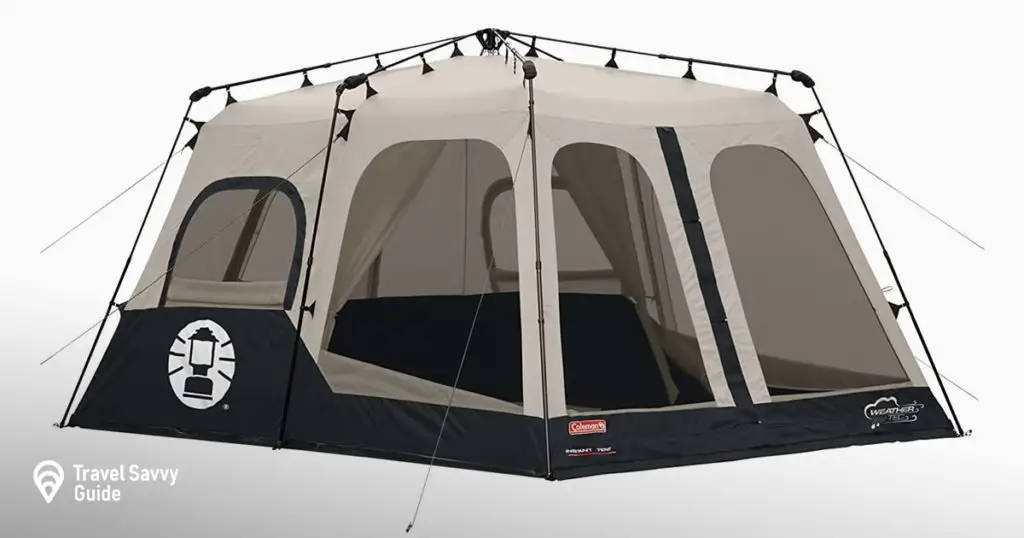
Key Features
- Sleeps: 8
- Size: 168 x 120 x 80.5 (in)/427 x 305 x 205 (cm)
- Size packed: 48 x 15 (in)/121 x 38 (cm)
- Weight: 35.2lb/16kg
- Materials: Coated double-thick nylon
- Seasons: 3
- Spacious 8-person tent has enough room for 2 queen-size airbeds.Number of Windows : 7
- Sets up in 1 minute in 3 easy steps
- WeatherTec system with patented welded floors and inverted seams to keep you dry
- Rugged Polyguard 2X double-thick fabric for reliable, long-lasting use
- Measures 14 x 10 feet with 6-foot 7-inch center height
The Coleman Instant 8-Person Tent is at the upper end of our $200 budget, but great if you want a lot of space. With enough room to fit 2 queen-sized air beds, this cabin-style tent has a lot of storage space with interior pockets. You can choose to separate the interior space – with two separate bedrooms or one bedroom and a living area – or you can have it as one open space.
The rainfly is built into the tent, making assembly easier. The double-layered nylon material is coated using Polyguard – a strong coating that keeps rain and wind at bay. Plus, this model uses Coleman’s WeatherTec system – patented welded floors and inverted seams means that rain should be kept out. As it is a cabin tent, it uses guy lines and stakes. The stakes that come with the tent are a little flimsy, so users suggest replacing them with metal ones.
You may think that a large tent may take a long time to put together, but that doesn’t seem to be the case here – the poles are pre-attached and they state it can be put together in 60 seconds. The only downside is that the parts can be tricky to come by if they need replacing. You can check the latest price for it here.
Pros
- Lots of interior space, including a decent amount of headspace and room to store gear
- Good weatherproofing
- Quick to put together
Cons
- The stakes provided are a little flimsy
- Replacement parts can be hard to come by
Coleman Hooligan – Best for Small Families
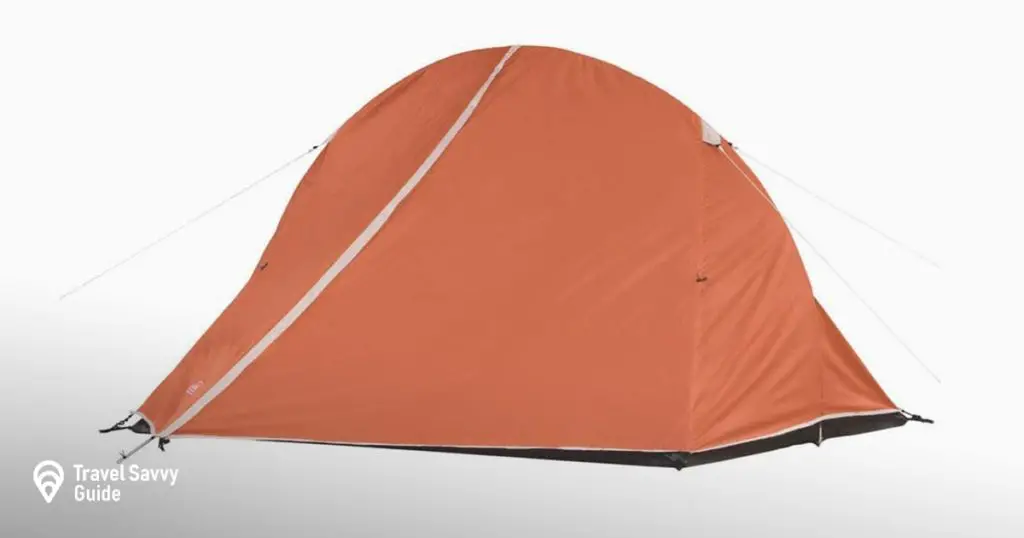
Key Features
- Sleeps: 4
- Size: 108 x 84 x 49.5 (in)/275 x 214 x 126 (cm)
- Size packed: 30 x 6 (in)/76 x 15 (cm)
- Weight: 7.8lb/3.5kg
- Materials: Coated double-thick nylon
- Seasons: 3
The Coleman Hooligan is a small dome tent – although it’s advertised as a 4-person tent, it’s better suited for 2 adults and 2 kids. It has a simple design with a vestibule for storage. It comes with internal storage pockets for small items.
Like the previous tent on this list, it uses the WeatherTec system with welded seams. It has a full rainfly that extends down to the ground, with a mesh interior and a vent in the ridge to improve ventilation. The rainfly can be removed – perfect for dry nights if you want to look at the stars. However, the stakes are flimsy, so users recommend replacing them with stronger ones.
The setup is really easy with continuous pole sleeves (meaning you won’t catch the poles on any gaps in the material). Users find it simple to put together. You can find out more about it here.
Pros
- Lots of ventilation with removable rainfly
- Good weatherproofing
- Easy to put together
Cons
- Small – would be cramped for 4 adults
- Stakes are flimsy
Kelty Late Start – Best for Solo Travellers
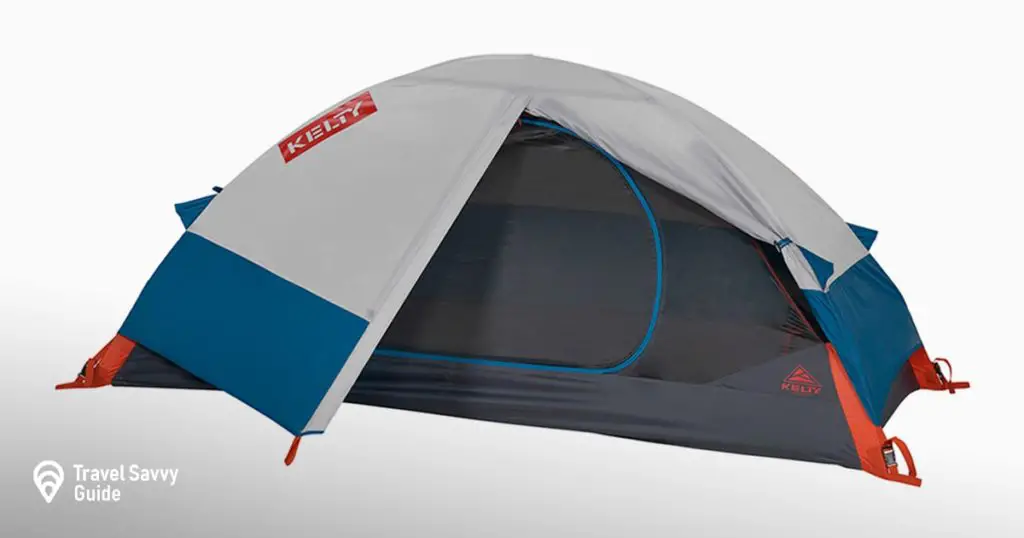
Key Features
- Sleeps: 1
- Size: 85 x 40 x 30 (in)/216 x 102 x 76 (cm)
- Size packed: 15 x 7 (in)/38 x 18 (cm)
- Weight: 3.7lbs/1.7kg
- Materials
– Rainfly: 1800mm Polyester
– Floor: 1800mm Polyester
– Walls: Mesh - Seasons: 3
- SUPER FAST SETUP: Kelty’s quickcorners make setting up fast and easy – as it should be. Pole sleeves at the tent corners matched with pre-bent aluminum poles for a formidable frame, Shark Mouth stuff sack for EZ packing up in the morning
- RUGGED + ROOMY: Durable 68D polyester fabrics in the tent bathtub style floor, flysheet are waterproof and built to last – roomy interior sports a peak height up to 56 inches within a simple single door design
- WATERPROOF POLY FLYSHEET: full coverage rainfly in 68D Polyester / 1200 mm / C0. Additional guyouts provide ample air flow even in rough conditions while keeping your buns (and gear) dry and safely nestled inside
- PROTECTING NATURAL SPACES: Kelty is 1 of 4 founding members of The Conservation Alliance, and has always strives to protect wild spaces. All tents are made with DWR/PFC Free fabrics and coatings, reducing waste and negative environmental impacts
- NITTY GRITTY: 1 door 1 vestibules (lots of gear storage with inner gear pockets to boot) featherlight stakes, 2 pole setup. 1P model: 20.6 sq. ft., 37 in peak. 2P model: 30 sq. ft., 40 in peak. 4P model: 56 sq. ft., 56 in peak
The Kelty Late Start is perfect for solo adventurers and backpackers. It’s a small dome tent with a decent living space, with a single vestibule for storage.
It has decent weatherproofing, with a fully waterproof rainfly that extends all the way to the ground and sealed seams. It doesn’t come with a footprint, which means you’ll have to buy one separately.
The main selling point of this model is the setup – described as ‘lightning fast’ setup in any weather, even if you’re setting it up in the dark. The poles are pre-bent for easy setup, and it can be done in less than ten minutes. You can find out the latest price for it here.
Pros
- Very quick and easy setup
- Good amount of space for a one person tent
- Good waterproof rainfly
Cons
- Doesn’t come with a footprint
Frequently Asked Questions
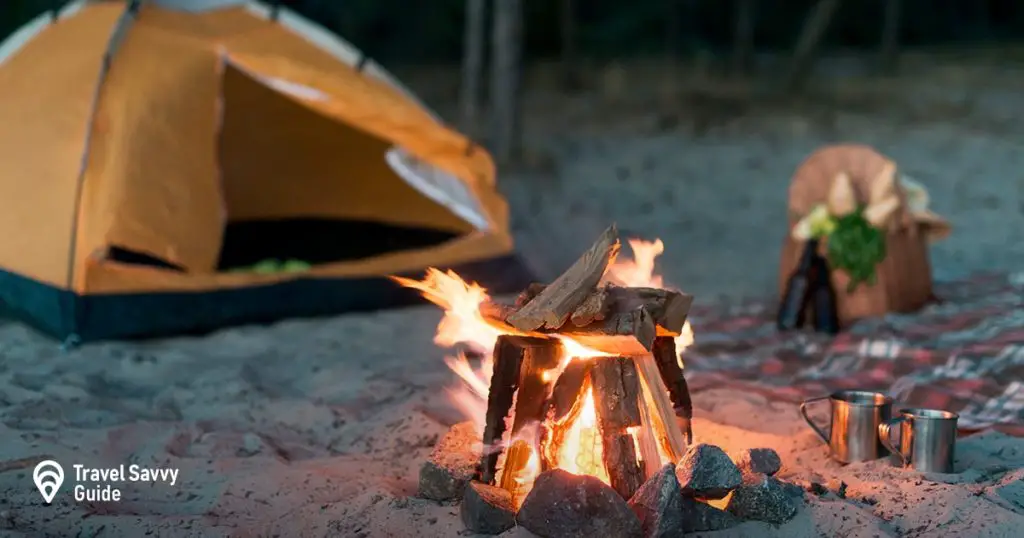
Do tents come with warranties?
It depends on the manufacturer, but some come with limited warranties on manufacturing defects.
Can I waterproof a tent myself?
Yes – you can buy sprays which allows you to apply waterproof coating to a tent. This can be a fairly cost-effective way of providing extra weather protection to your tent.
How can I keep the costs of camping down?
There are several ways you can do this:
- Look for cheap or free places to pitch your tent. Plan all your activities around this – some campsites allow you to camp for free.
- Don’t be fooled into thinking you need all the latest gear. Although new gear is nice, you may be able to get by with what you already have at home
- Prepare food at ‘home’ – consider buying or borrowing a camping stove so you can prepare food at the campsite rather than eating out
- Borrow equipment – see if your friends and family have equipment, like fold-down chairs, that you can borrow
What kind of tents are good for travelling?
Lightweight tents are good if you’re travelling – just make sure you pick the right tent for the weather (you may want a warmer tent if you’re going to visit the Iceberg Trail in Montana, or a tent with great ventilation if you’re visiting somewhere more exotic like the Kawasan Falls).
What do I need to bring in case of damage to my tent?
You can buy self-adhesive patches to repair holes in your tent, but duct tape is a pretty decent way to patch up holes on the go – it might be worth bringing a roll with you just in case.
Conclusion – Which Tent is Best?
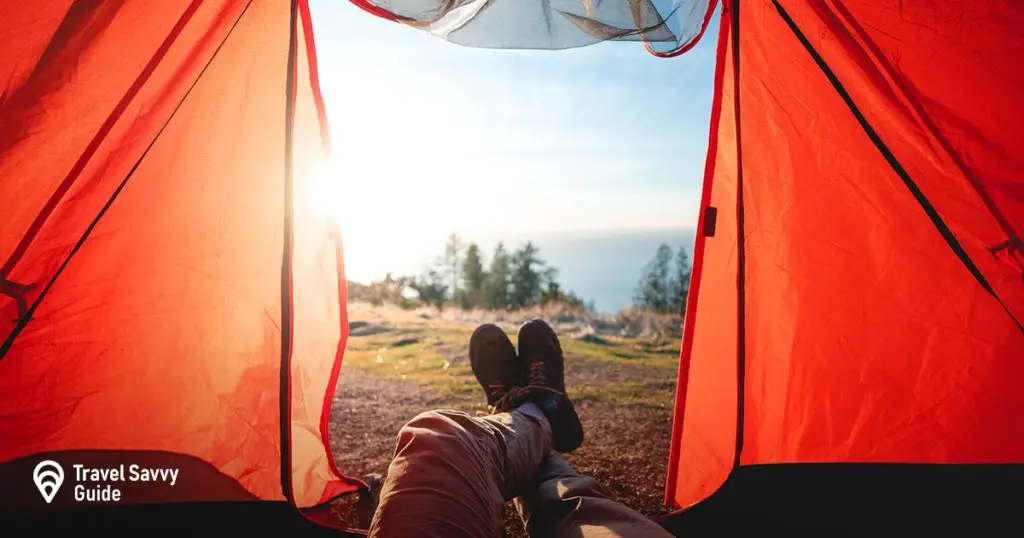
Any of these tents are great choices – we think they are all of a high standard considering their low price point.
If you’re camping as a family, we’d recommend the Coleman Instant 8-person tent. It’s easy to put together, spacious, and offers great weatherproofing – making it a versatile tent for all kinds of weathers. Plus, it’s an investment – the materials should last a long time, providing you plenty of camping adventures in the future.
If you’re a solo traveller, we’d recommend the Kelty Late Start. It’s a basic tent, but it is lightweight and small, perfect for fitting into your backpack, and it’s really easy to put together thanks to the intuitive design.
We hope this has helped, and if you’re still looking for more information about camping gear, why not give these a read?
